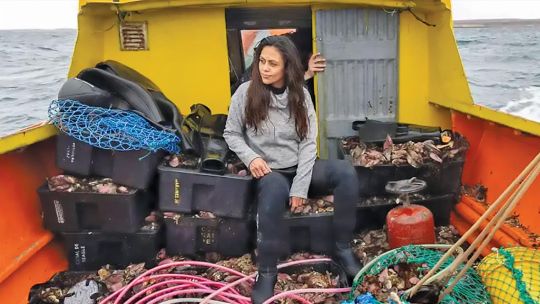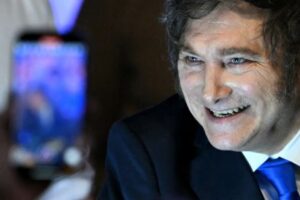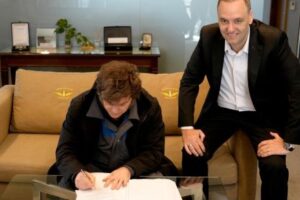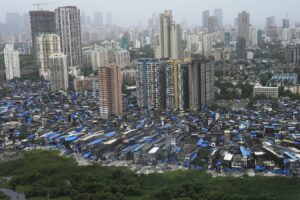
The giant bones wedged into the sand give this corner of Península Valdés the atmosphere of an alien planet: rib-cages over two metres long, buried like lampposts, tilted into an arch. The whalebones seem light and in their off-white colouring they glint against the choppy sea of a grey August morning. This is the village of Playa Larralde, an accumulation of shanty huts reached after travelling over bumpy gravel and mud roads beyond Puerto Pirámides. Small constructions on the side of the bones defying the wind, which in this region does not beat about the bush.
The cold does not matter here. It is Magellan season, people go out and take advantage, as they did yesterday and the day before yesterday, weather permitting. With the high tide, the fishers start a ritual repeated daily: on motorboats, pulled by a tug which will get them into the sea, they will seek the spot some of them know on the high seas and there they will dive in search of shellfish. Thus, they begin an art handed down from generation to generation, offering a sustainable and popular economy developed in one of the world’s most unique locations.
In a province where industrial fishing is one of this country’s biggest earners of foreign currency, these small economies will not budge. They tell other stories.
Hands in the water
They are far out of range of the radars controlled by international trawlers at the 200th mile (within this boundary, maritime law grants the country sovereignty over soil and subsoil resources on the continental shelf; beyond it, they are international waters, open to all). They are also far from the provincial vessels on national waters which contribute 30 percent of exports. Chubut is the country’s second most important fishing province. A dollar-minting machine in the form of prawns and shrimp. Far from all that, the artisanal trawlers are small dots on gulfs surviving daily and lingering in a trade which does not give them any dollars, but for those brave enough to go there it offers, besides a few blows, the adrenaline only known by those who spend their lives at sea.
Shellfish belong to the animal world with a huge variety. The entire invertebrate world would fall into this category, as well as Magellan mussels and scallops. They both belong to these organisms with two valves, like castanets. In this part of the San José Gulf, as in the entire region of the Patagonian seas, there is an abundance of molluscs, crustaceans and fish. There are mussels, spider crabs, sardines and hake. In August, Magellan mussels enter the underwater window display. In order to search for them, fishermen dive daily into deep waters and collect them as though they were weeds in an underwater prairie. Artisanal fishing has its variants: in addition to diving, fishing with a coastal net and the extraction of bivalve molluscs and octopuses. This all amounts to work taking its toll on the body and to daily bargaining with the environment.
In her book A Field Guide to Getting Lost (Una guía sobre el arte de perderse), US writer and activist Rebecca Solnit talks about the gift of paying attention to one’s environment, reading the details of light, small differences along the road. She calls it the language of the earth itself.
José Signorelli is a self-defined full-time fisherman. He boasts about his knowledge of the sea and being able to pinpoint a spot with only two points of references. In a few minutes, he improvises a masterclass in fishery. “With Magellan mussels, one removes soil, you have to know how to take advantage of the current. With scallops you come and go, you cannot stay still. With clams it’s different. It’s more like growing potatoes. You have to fan with your hand and they show up, springing from the soil,” he explains.
“You have to be a full fisherman: an octopus fisherman, a coastal gatherer, a netminder, a seafood diver, a deep-sea fishing guide and know how to clean fish. And you have to be here all year. Then you can call yourself a fisherman,” he concludes. Signorelli is used to defining his trade. Both José and the rest of his colleagues are interviewed semi-regularly by documentary filmmakers arriving from other parts of the world to shoot this way of life.
Before going into the sea, the divers put hair conditioner on their suits, for the material to slide better on their bodies. Around 10 years ago, José would mark the spots where he would later fish during his free time. He did this while practising holding his breath and wandering on his motorboat around different spots of the gulf. He grew up here. This sea is his childhood backyard. Year after year, he saw “resources” waning. And he gives numbers to give an idea of how swiftly it is vanishing: “Three months ago, in two hours we would get 40 trays of scallops. Today, after five years, we got nothing.”
He claims to know the gulf by heart, says he does not need a GPS because he has a “mental radar.” He complains and gets angry about the way Magellan mussels and scallops are running out so quickly. In season, work hours are all or nothing. Collecting until filled to the brim without stopping. He and his workgroup see that differently. Along sustainable lines, they know what must be avoided is to go all the way. “We can’t pillage the gulf, otherwise we won’t even have seeds to sow,” says José.
Renaissance
The renaissance of the work of shellfish divers in this corner of the South has a date. It has consolidated a low-impact alternative to change the desertification fishing had caused, spilling over into the neighbouring San Matías Gulf.
It was in the mid-1970s when they started to promote that patient and endurance diving to prevent what had happened there from happening in Península Valdés, where what some once called a “shellfish stew” had become an empty plate. Joint work between scientists and fishermen which survives to this day; a link which shows how this crosswise work can be furthered and started by a pioneer biologist, José María ‘Lobo’ Orensanz, who together with a group of collaborators conceived a proposal to change the type of fishing until then, which was like a rake on the sea bed, choosing a more environmentally-friendly option. Half a century later, despite the precariousness they sometimes face, it survives.
“Here time is boss. To go into the sea, for the paths to let us through; to come home. It rains like this and then there’s no way for the vans to come. And if it doesn’t rain but the tracks look like this, the lorries which carry the product won’t arrive so we can’t go fishing either,” ponders José.
Since 1993, the Puerto Madryn Artisanal Fishermen Association gathers those performing this work in the Peninsula. Even though there is still much to be done, over the last few years they have managed to give more visibility to the trade.
Eduardo De Francesco is another historic local. The captain of the boat we will board later, where we will ride for 20 minutes up to a spot they know by heart. There he will pay attention to every detail, not only for the divers, José and his daughter Jazmín (one of the few women in the trade) to find what they are looking for.
He must also look after the oxygen to reach them and to keep whales, who swim by with curiosity to see what is going on, from getting too close. There are many this time of year. Sometimes work is impossible. Other times, they have to track their dives to keep them from getting entangled with the ropes. One false move, one extra turn could capsize the motorboat in a flash. A young whale suddenly appears, coming close and showing its head while José is underwater. Eduardo swears. What is a tourist’s target for photos is a hindrance to their work and a hazard.
“Every time we take the motorboat out, we fork out 50,000 pesos, that is if we don’t break anything, of course. We can call it 20,000 pesos for manoeuvres alone. We can’t afford to waste time,” says Eduardo.
Deep underwater, seafood banks await. They are mounds on the sand, where crabs jump around, together with sea snails and spider crabs. Scallops, mussels, pink or white clams, Magellan mussels. The divers will spend hours underwater. Their return to the surface must be cautious. Decompression is a danger if diving time is exceeded. This is not like scuba-diving. It is a different story. A routine which involves concentration and hard work.
The water pipe is the umbilical cord with the motorboat. On the surface, Eduardo pays attention to oxygen reaching them at all times. He also receives the Magellan mussels sent from under the sea on the brailer, a kind of netted bag which looks like butterfly nets. When each cargo arrives, announced with a tug of the rope, Eduardo throws the contents into plastic trays piled up as the afternoon goes by.
There are good days; others, such as this cold windy day, not so much. The boat rocks, it is choppy out there. The previous day they were a few metres beyond, where now they fish from another motorboat. The neighbouring vessel is manned by José’s brothers and a dog guarding the seas.
Constellation of waves
José and his brothers belong to a breed of fishermen. Opposite the beach, in a mud hut, the souvenirs of his forebears tell a story: photos, shark teeth, dried seahorses, bait. A huge family site where a small collective memory is improvised telling their story and that of many more. There are the women making their mark, with a history of octopus fishing in summer, the mother who spent afternoons or mornings with the hooks to find octopuses, and the father who went out to sea. The children who yearned for such a life: outdoors, by the waves.
De Francesco also belongs to a fishing tradition, to which his brothers also dedicate themselves. His daughter Jazmín, 28, dives daily looking for shellfish and has no problems admitting that one of her motives for picking this line of work is to share time with her father. When the season ends, she returns to what she was doing before at the other extreme of this food chain: cooking the shellfish where she has learned recipes handed over from generation to generation.
The peninsula features an uncommon phenomenon: the tides in the Nuevo and San José gulfs (separated by the Ameghino isthmus) are not simultaneous but inverse – when the tide rises on one side, it ebbs on the other. The lives of the fishermen have been organised around this sequence for several decades. The artisan fishermen were there before the Valdés Peninsula was declared a World Heritage Site and thus figure in the organisation’s plan as the only activity permitted to extract natural resources within the protected area. There are studies indicating that the indigenous communities of the zona, the Tehuelches, ate seafood and even mastered diving techniques.
But this pearl of the Atlantic shoreline is no bubble. The gulfs of this region are connected. The marine biology specialist Raquel Perier, a researcher and a member of the Golfo San Matías multi-sector grouping, knows this zone and has fought for its protection on the street, understanding it as a continuity. She comes from that generation which in the 1990s persuaded the neighbouring province of Río Negro to approve the law banning the exploitation of fossil fuels in the San Matías Gulf, the famous Law 3,308. She now explains with pedagogic clarity that both gulfs belong to the same marine coastal system which communicates them and that in its totality functions to explain both its marvels – southern right whales, sea-lions, scallops, octopuses, algae – as the risks they run. Especially the recent advance of a bill which contemplates the construction of a gas pipeline and port in Piedras Coloradas, less than 100 kilometres from where the fishermen dive every day.
The fishermen often ask what will become of them. In mid-August, when the whales are teaching their young to swim and frisk their tails, a plebiscite denounced as fraudulent was held on the environmental impact of the 570-kilometre oil pipeline between the Vaca Muerta Sur and Sierra Grande and the export terminal being constructed by YPF with the assurance that it would be the key to Río Negro and Argentina being able to export energy worldwide.
The pipeline will transport fuel from the Loma Campana oilfield in Vaca Muerta, Neuquén to the port of Punta Colorada where it will provide the cargo for tankers operating offshore with single-buoy moorings 6.7 kilometres off the San Matías Gulf. The objective is to increase the capacity of draining oil from the Neuquén basin by 350 percent in the next three years.
“We reject that because this region stands out for its great biodiversity. The surroundings of the oil port would be a dirty environment due to the micro-spills which occur in those places, produced by the connection between the boats and the tubes transporting the crude oil from the storage tanks. That would transform it into a zone of highly negative impact for the species present,” explains Perier.
That invasion would amount to slashing an environment which for decades has been moving in the opposite direction in the search of sustainable solutions for this region where Mother Nature has such luxuriant variety. The very existence of these fishers who dive was created as an alternative to the other system which was wiping out the scallops, bearing witness to the underlying efforts aiming at an integral construction between jobs and the environment.
When you speak of the risk of jobs disappearing for fishing communities, you are talking about generations and generations who worked and passed on the baton in this zone, in part as fishers and in part as caretakers.
About the craft fishers
Since each boat is artisanal and sailing in provincial waters, it has a maximum permitted length of nine metres according to Chubut regulations, allowing around 10 people to enter with the skipper and two divers as a minimal crew. Inside the vessel, there is a GPS, trays of fish, maté, a canister to heat the water, windbreakers. Everything which can be found is a work tool, as in a harvest tractor, things needed aboard when spending many hours in stormy weather.
The 2022 book, La pesca artesanal en Argentina (“Artisanal fishing in Argentina”), edited in 2022 by the Centro para el Estudio de los Sistemas Marinos and Vigo University, estimates a total of 2,922 persons involved in artisanal sea-fishing in this country. Over half of them are in Buenos Aires Province, followed by the provinces of Chubut (with over 1,200 kilometres of coastline) and Río Negro with 740 and 409 people respectively.
Over and above the passion for and betting on an activity which has its traditions, the working conditions hang on a thread. It is a risky job with heavy expenditure (the diving-suits, the fuel, paying a tug to take them to sea, the spare parts) and almost zero social security, healthcare or pension payments. A few accompanying policies are needed, say the workers, to lower the odds. Much depends on the forecast of each fisher. As José tells it, the scallops and Magellan mussels pay best. In times of abundance, two hours of diving can have you heading home with 100,000 pesos in your pocket. But on a bad day you can dive for five hours and not even make 50 pesos. So the secret lies in saving and predictability.
Yet bit by bit in recent years, thought has begun to be given to such jobs in line with a horizon which recognises their contribution towards thinking in terms of popular economy, also enriching the discussion of food sovereignty. The sea is there and starting to be seen with thought to its potential, even if today 95 percent of what is fished in Argentine waters is exported to the international market, especially to Spain, Japan, China, Brazil, the United States and France.
In the opposite direction to industrial fisheries with their mass exports, this work is sustained at a different pace with memories and taking alternative routes to those offered by the extractionist dragnet.
Somebody who knows all about this and has been accompanying it for years as a researcher at the Centro Nacional Patagónico is Ana Cinti, whom the fishers call La Colo. She has spent whole days among the fishers, knowing their practices, their maps, their intimacy.
Defending this activity because of its history, its value and its sustainability, she says: “Sometimes it seems that these activities are being lost and although the world is moving in a different direction, such systems of production have great value. That knowledge, that relationship to the environment, that way of doing things in collaboration, these are jobs which coordinate other possible worlds in this context. So much knowledge goes into these practices, these ways of doing things, these ways of making relationships … They read the cycles like a farmer, a peasant who knows the seasons, who registers in what moment to plant the seed in what phase of the moon. Those multiple tasks require knowledge, a relationship with nature and an apprenticeship on the basis of that contact.”
Such tasks require a different kind of being in the world, a world where whales play with the boats, the working days are tough and much longer and where the absolute boss is the one and only sea.
* This article was originally published in Crisis magazine. The production of this article was supported by the Pulitzer Center; Photos taken by Sofía López Mañán.
related news
by By Natalia Gelós*, Crisis via El Observador – Perfil





